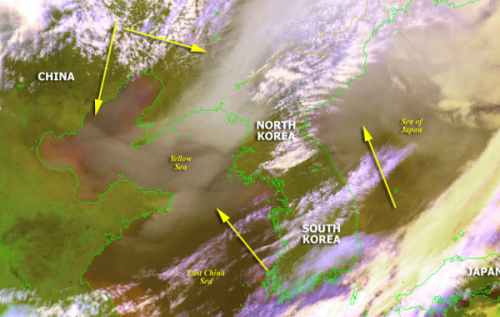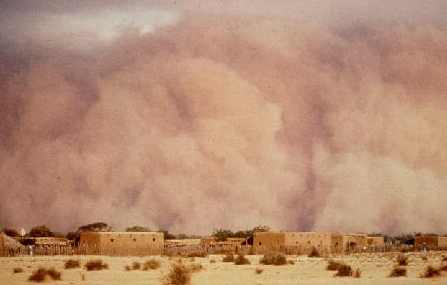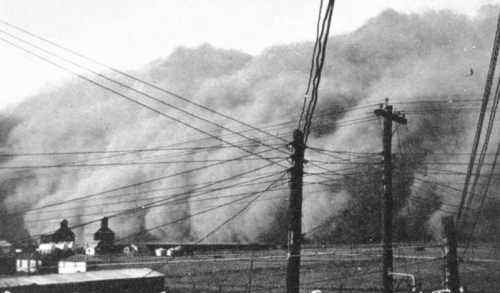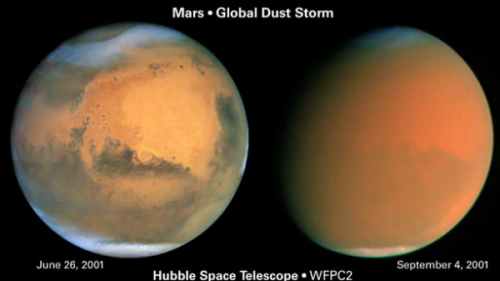 |
 |
| Home | Welcome | What's New | Site Map | Glossary | Weather Doctor Amazon Store | Book Store | Accolades | Email Us |
 | |||||||||||||||||||||
Weather Almanac for JUNE 2002DUST IN THE WINDAs any housekeeper or resident of arid regions can tell you, dust in the air presents a never-ending scourge. Dust from industrial and other human activities are major air quality concerns across North America. For example, road traffic, including particles generated from tire and break wear, deposits millions of tons of dust per year over our larger cities.
Recent research by scientists from Israel's Hebrew University and the Weizmann Institute has revealed that excessive dust may actually amplify the process of desert formation. Human activities -- such as grazing and agricultural cultivation -- which expose and disrupt the topsoil, increase the dust burden in the air. As more dust reaches the clouds, they in turn produce smaller rain drops that grow more slowly and thus yield less rainfall over their lifetime. This process can exacerbate drought conditions and contribute to the further or continued desertification of the region. Dust plays an important role in the planetary heat balance by intercepting sunlight before it reaches the ground. By shading the Earth's surface from the sun's radiation, dust aerosols have the same cooling effect as rain clouds. This month, however, I want to mainly focus on blowing dust and dust storm events, because, if the first four months of 2002 are any indication, North America could be facing a dusty summer, not only from dust generated on the continent, but also from natural dusts immigrating from the Asian interior and the Sahara Desert. [For purposes of this discussion, dust will mean fine, solid earthen particles — soil, silt or sand — and not industrial particle releases.] Over much of North America, particularly the arid West and much of the Great Plains and Prairies, severe drought conditions this year continue raising fears of water shortages not seen since the Dust Bowl years of the 1930s. For example, Montana officials openly fear that a fourth straight year of drought could bring a return to the Dust Bowl days of the 1930s. Blowing Dust and Dust StormsMany small-scale dust events are caused by localized high winds associated with the passage of weather fronts and systems, or by strong convective storm events such as a thunderstorm outflow winds or downbursts. In many areas of the US western and plains states, blowing dust (and sand) events are becoming common hazards, particularly to highway travel due to severe reductions in visibility. The US National Weather Service will issue a blowing dust (blowing sand) advisory whenever, the presence of local windblown dust/sand reduces visibility to 400 metres (0.25 miles) or less. A blowing dust (blowing sand) warning is issued when blowing dust (or sand) reduces visibility to near zero.
On those occasions when blowing dust covers a large area, the event is termed a dust storm. Large-scale, duststorm events are often characterized by sustained high winds at the surface that associated with synoptic-scale wind storms. Dust storms can last from 3 to 4 hours to 2 to 3 days, and often occur in the late winter to early spring when extreme pressure gradients are formed. US observational practices define a dust storm as occurring when horizontal visibility is less than a kilometre (5/8 mile) but not less than 500 metres (5/16 mile). When visibility falls below the 500-m limit, the event is termed a severe dust storm. The US National Weather Service issues a dust storm warning when blowing dust/sand reduces visibility to near zero. Global Dust StormsWhen the blowing winds are strong and persistent, dust from large deserts or bare agricultural land can ascend into the upper atmosphere and hitch a ride on the global circulation to distant lands. The past two years, China has been the source of major dust storms whose particles have left the Asian mainland and even crossed the Pacific Ocean to reach American shores. This April (2002), a great dust storm sent a cloud out of China and into the Pacific heading for our western coast. The tell-tale yellow stain from this soil tinted the air enough to make it visible to NASA satellites overhead. If you had looked skyward during the passing of that cloud, the sky would have appeared hazy white due to the scattering of sunlight by the dust particles (arrows in photo below).  Satellite Photo: 8 April 2002 Courtesy of NOAA, US Dept of Commerce The previous April (2001), an Asian dust storm kicked a million-ton dust cloud from the Gobi and Takla Makan deserts in Mongolia and China, respectively. Blown by global air currents, the leading edge of this cloud reached the US West Coast on April 12. Two days later, it had crossed the continent and moved off the eastern shoreline heading out into the Atlantic.  African Dust Storm Courtesy of NOAA, US Dept of Commerce The Sahara Desert has long been known for its dust and sand storms, and many special names have been given to these unwelcome episodes including: the haboob, the Harmattan, and the simoom. Sahara dust is not only transported by the winds across northern Africa and into Europe, it can reach westward to the Caribbean/West Indies waters. During many past summers, the National Weather Service Office in San Juan, Puerto Rico has issued air pollution alerts due to the dust originating from the Sahara. Local dust storms. and rising warm air initially lift the Saharan sand to altitudes of around 4500 metres (15,000 feet) where upper-level winds carry the dust westward. While the larger particles fall out as the dust crosses the Atlantic, the smaller particles continue into the northeastern Caribbean Sea, at times, even reaching southern Florida. These dust clouds cause skies to turn hazy and reduce visibility, but the dust likely has more impacts than altering sky colour and visibility. Researchers have linked the Sahara dust to red tides, fish kills and coral destruction.  NASA Satellite animation of dust moving out of Africa and across the Atlantic. The Dust Bowl of the 1930sDust storms can also have a devastating effect on agriculture -- both crop and livestock production -- natural biota, commerce, and the health and well-being of the residents in the effected area. In their severest form in the United States and Canada, dust storms have been called black blizzards, many of which plagued the Dust Bowl years.
The Dust Bowl years of the 1930s in Canada and the United States comprised one of the major environmental impacts on society during the last century. Canadians rated the Dust Bowl as the Number 3 weather story of 20th Century, and the US rated it high on their top event list of the century. The decade combined a large-scale, long-term meteorological event with poor agricultural practices with conditions exacerbated by the Great Depression to bring misery to millions in the two nations. In the United States, the Dust Bowl affected 100 million acres of the Great Plains and forced the migration of hundreds of thousands of families to other states, and undoubtably changed the lives of every Plains resident. The story was similar in Canada. The Prairie Provinces experienced only 60% of their normal rainfall between 1933 and 1937. As a result, the few crops that germinated withered in the parched fields, thousands of livestock starved and suffocation, and over a quarter-million people across the Prairies abandoned their land.
The period began in 1931 when severe drought covered the midwestern and southern US plains. As the crops died, dust from the over-plowed and over-grazed land, whipped skyward by strong, dry winds, formed great dust storms that became known as black blizzards. In 1932, fourteen dust storms were reported in the US, but in the following year, the number jumped to 38. In May 1934, the drought and great dust storms began to spread out from the Dust Bowl area. The worst drought in US history covered more than 75 percent of the country and severely affected 27 of the 48 states. The Agriculture Department's Yearbook of Agriculture for 1934 sadly reported: "Approximately 35 million acres of formerly cultivated land have essentially been destroyed for crop production.... 100 million acres now in crops have lost all or most of the topsoil; 125 million acres of land now in crops are rapidly losing topsoil..."
The most eventful dust storm of 1934 struck on 9 May. The storm swirled an estimated 350 million tons of brown earth from Montana and Wyoming skyward where it was captured by extremely strong, upper-level winds, The soil was swept eastward toward the Dakotas and would eventually covered much of the nation, causing extensive damage and depositing soil dust over much of the eastern regions. By late afternoon, the storm had reached Dubuque, Iowa and Madison, Wisconsin and headed for Chicago. By evening, the black blizzard began depositing 12 million pounds of dust on Chicago -- four pounds for each resident in the city. Midday, 10 May found Buffalo, New York darkened by dust and the advancing gloom front stretched southward over several states at upwards of 100 mph (160 km/h). By dawn of 11 May, the dust cloud dust had rolled eastward, settling over Boston, New York, Washington and Atlanta before moving out to sea where it dusted ships 300 miles (500 km) offshore.  A dust storm approaching Spearman, Texas, April 14, 1935. From: Monthly Weather Review, Volume 63, April 1935, courtesy NOAA. Sunday, April 14, 1935 would become known as Black Sunday as the worst "black blizzard"of the era started in eastern Colorado and proceeded through western Kansas to Texas and Oklahoma. In mid-afternoon, the temperature began to plummet. Without warning, an immense black cloud appeared on the horizon advancing forward at 60 mph ( 96 km/h). Birds began to chatter nervously as the airborne dust turned day into night. Many believed the world was coming to an end. In Dodge City, Kansas, 60 mph ( 96 km/h) winds drove dust so thick that total darkness prevailed for 40 minutes and was followed by three hours of semi-darkness. The Dust Storm of Black Sunday was immortalized by folk balladeer Woodie Guthrie in his collection Dust Bowl Ballads. In the song, he conveyed the feelings of many caught under its heavy hand:
[For more on the Dust Bowl, visit the PBS site for The American Experience: "Surviving the Dust Bowl" or visit the University of Wisconsin-Eau Claire site: The Dust Bowl. Texas Humanities Resource Center presents an exhibit of Dust Bowl photographs. ] How Dust MovesDust storms and black blizzards are the ultimate expression of blowing dust. Essentially, a dust storm is born when strong winds traverse dry, arid land with little vegetation and elevates tiny particles of sand, dust and other debris skyward. To see the origin of blowing dust, we must get down on our knees and take a closer look at the surface of the earth. It all starts with a process known as aeolian (or Eolian) transportation, the process whereby surface dust particles are picked up and transported by the wind. That transport may occur through suspension, saltation, or creep of the dust particles. [For more on these aeolian processes, see the accompanying article: Aeolian Transport.]  If the lofted dust and debris form a large cloud or wall of dust that sweeps forward with the wind across large areas, the blowing dust event can be called a dust storm. Dust storms can be caused by various meteorological events usually falling into one of two main categories: convective events and large-scale, non-convective events. Convective-event dust storms are usually associated with thunderstorm outflows or downbursts. They are far less predictable than the large scale non-convective events. Therefore, the duration of these dust storms depends on the processes which form them. One caused by a microburst may last but a few seconds, while one caused by a downburst may last several minutes. Dust storms caused by winds associated with a dry squall line may last for hours. Convective event dust storms usually form during the late afternoon in the spring and summer when daytime heating is at its peak. Large-scale, non-convective events are associated with sustained high winds at the surface that are often associated with cyclonic wind storms. These dust storms can last from 3 to 4 hours, or for several days depending on the overriding weather situation. Large scale, non-convective dust storms generally occur in the late winter or early spring when extreme pressure gradients produce high wind speeds and surfaces are often dry and bare. Approximately two thirds of all dust storms are caused by strong winds associated with the passage of fronts and troughs or the down mixing of upper level winds. And FinallyWhile dust storms are a constant threat on Planet Earth, Earth is not the only body in the solar system to experience them. Mars is well known for its immense dust storms that often obscure the surface from our view. Recent NASA probes to Mars have shown dramatic pictures of dust storms that completely obscured surface detail from the orbiting satellites.  Two dramatically different faces of Mars appear in these comparison images showing how a global dust storm engulfed Mars (4 September 2001). Credit: NASA, James Bell (Cornell Univ.), Michael Wolff (Space Science Inst.), and the Hubble Heritage Team (STScI/AURA) Learn More From These Relevant Books
|
|||||||||||||||||||||
 |
To Purchase Notecard, |
Now Available! Order Today! | |
 |
 |
NEW! Now |
The BC Weather Book: |


